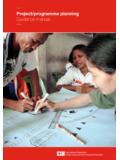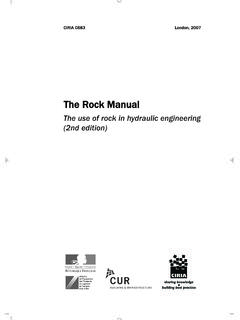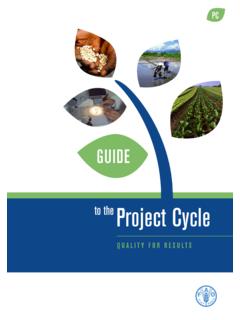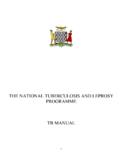Transcription of GUIDE TO THE PROJECT CYCLE - Food and …
1 GUIDE . TO THE. PROJECT CYCLE . APPENDIX 1. 2015. GUIDE . TO THE. PROJECT CYCLE . APPENDIX 1. 2015. The designations employed and the presentation of material in this information product do not imply the expression of any opinion whatsoever on the part of the Food and Agriculture Organization of the United Nations (FAO) concerning the legal or development status of any country, territory, city or area or of its authorities, or concerning the delimitation of its frontiers or boundaries. The mention of specific companies or products of manufacturers, whether or not these have been patented, does not imply that these have been endorsed or recommended by FAO in preference to others of a similar nature that are not mentioned. The views expressed in this information product are those of the author(s) and do not necessarily reflect the views or policies of FAO.
2 FAO, 2015. FAO encourages the use, reproduction and dissemination of material in this information product. Except where otherwise indicated, material may be copied, downloaded and printed for private study, research and teaching purposes, or for use in non-commercial products or services, provided that appropriate acknowledgement of FAO as the source and copyright holder is given and that FAO's endorsement of users'. views, products or services is not implied in any way. All requests for translation and adaptation rights, and for resale and other commercial use rights should be made via or addressed to FAO information products are available on the FAO website ( ) and can be purchased through TABLE OF CONTENTS. FOREWORD vi ACRONYMS vii PART ONE: THE TECHNICAL COOPERATION programme 1. CHAPTER 1 - Introduction 2. Purpose of the TCP 2.
3 TCP appropriation management 2. CHAPTER 2 - TCP Criteria 6. The TCP criteria for development TCP assistance and TCP facility 6. The TCP criteria for emergency TCP assistance 12. CHAPTER 3 - The TCP Facility (TCPf) 16. PART TWO: THE TCP PROJECT CYCLE 19. PHASE 1 - Identification 20. Alignment with the strategic framework 20. TCP pipeline in the CPF 20. Submission of a request for TCP development assistance 21. Submission of a request for TCP emergency assistance 23. Opening of a TCP facility pipeline 24. Pre-screening process 24. Change of status to active pipeline 26. Appointment of the LTO 26. First Technical Review 26. Establishment of the PTF 27. Concept Note 27. Funds availability and change of status 28. TCP manual 2015. PHASE 2 - Formulation 28. Basic principles 29. Gender analysis 30. Standards and policies for the input composition 31.
4 Inputs allowed under the TCP facility 36. Budget 37. PHASE 3 - Appraisal and Approval 38. The appraisal process of TCP development projects 38. Operational clearance 38. Technical clearance 39. Adherence to TCP criteria 39. The approval process of TCP development projects 41. The appraisal and approval process of TCP emergency projects 42. The appraisal and approval process of a TCPf 43. PHASE 4 - Implementation and Monitoring 44. Inception 44. Implementation 45. Monitoring and reporting 45. Monitoring 45. PROJECT extension 46. Budget revision, budget increase or decrease 48. PROJECT revision 49. Reporting 48. Phase II projects 50. PHASE 5 - Evaluation 51. PHASE 6 - PROJECT Closure 52. Operational closure 52. Financial closure 52. iv ANNEXES 53. Annex 1 - TCP Criteria 55. Annex 2 - Standard PROJECT Document 59. Annex 3 - TCPf Component Description (opening) 81.
5 Annex 4 - TCPf Component Description (closing) 87. Annex 5 - TCP Appraisal Sheet (TAS) 91. Annex 6 - Phase II TCP PROJECT 97. v TCP manual 2015. FOREWORD. Following the decentralization of the Technical Cooperation programme (TCP), the transformational change process and the Strategic Thinking Process that led to the reviewed Strategic Framework, member countries requested assurance that the TCP adapt to this new organizational context and remain a programme of importance and relevance as a means for accessing FAO's technical expertise. In December 2013, the Council endorsed a comprehensive document1 for the enhancement of the TCP, along with an implementation plan, to improve alignment to the Strategic Framework and enhance the strategic use of TCP resources. The document took into account the transformational changes in the Organization, and earlier guidance received from Council.
6 The plan was also reviewed and endorsed by the Corporate programme Monitoring Board (CPMB). The approved measures led to the simplification of TCP procedures through the revision of the TCP manual , including the alignment of procedures between the PROJECT CYCLE for trust fund projects and that of the TCP. Furthermore DGB 2014/532. sets out the policy, roles and responsibilities in relation to resource mobilization and the PROJECT CYCLE , aimed at enhancing the alignment of these functions to the implementation of FAO's Strategic Framework and empowerment of decentralized offices. Therefore this manual constitutes an integral part of the GUIDE to the PROJECT CYCLE and forms one of its annexes detailing specific guidelines for the TCP. This manual governing the use of the TCP appropriation is divided into two main sections: the first is dedicated to the specificities of the TCP (TCP appropriation, TCP criteria and the TCP facility) while the second focuses on the PROJECT CYCLE for TCP projects, detailing the specific TCP requirements throughout the six phases of the FAO PROJECT CYCLE .
7 While undertaking this exercise consideration was given to fundamental characteristics of the TCP, in particular the fact that the TCP appropriation is funded by the Regular programme (RP) and governed by the TCP criteria approved by the Governing Bodies. 1 2 vi ACRONYMS. ADG/RR Assistant Director-General/Regional Representative ADG/TC Assistant Director-General, Technical Cooperation Department CN Concept Note CPF Country Programming Framework DSA United Nations Daily Subsistence Allowance FAOR FAO Representative FPMIS FAO's Field programme Management Information System GOE General Operating Expenses HQ FAO headquarters LDC Least Developed Country LIFDC Low-Income Food-Deficit Country LLDC Land-Locked Developing Country LOA Letter of Agreement LTO Lead Technical Officer NPC National PROJECT Coordinator OSD FAO's Office of Support to Decentralization OSP FAO's Office of Strategy.
8 Planning and Resources Management PSC PROJECT Servicing Cost PTF PROJECT Task Force RO Regional Office RP Regular programme SIDS Small Island Developing State SO Strategic Objective SPP Short PROJECT Proposal SPD FAO's Standard PROJECT Document SRC Subregional Coordinator SRO Subregional Office TAS TCP Appraisal Sheet TCP Technical Cooperation programme TCPF Technical Cooperation programme Facility TOR Terms of Reference TSS Technical Support Service by FAO technical staff UNDAF United Nations Development Assistance Framework vii TCP manual 2015. PART ONE: THE TECHNICAL COOPERATION programme . 1. TCP manual 2015. CHAPTER 1 - Introduction Purpose of the TCP. The TCP was created to allow the Organization, drawing from its own RP resources, to make its know-how and technical expertise available to member countries and respond to its constitutional function to furnish technical assistance as governments may request 3.
9 The TCP allows the implementation of demand-driven technical assistance that can respond to governments' priority needs, catalyse change, foster capacity development and assist member countries in mobilizing resources. The TCP aims to provide FAO's technical expertise to its Members through targeted, short term, catalytic and sustainable projects. These projects address technical challenges in the fields of agriculture, fisheries, forestry and rural livelihoods that prevent member countries, either individually or collectively, from implementing their development programmes. The TCP may be used in all areas of action that pertain to FAO's mandate and competence that are covered by the Strategic Framework. At country level, TCP assistance should contribute to one or more country priorities as expressed in the CPF. At subregional, regional and interregional levels TCP.
10 Assistance should be aligned to the Strategic Framework, regional priorities and/or initiatives as expressed in Regional Conferences, regional technical commissions, and other relevant political processes and agreements. TCP projects are categorized as being either for Development Support (D) or Emergency Assistance and Support to Early Rehabilitation (E). The eligibility criteria, responsibilities for the approval process and, in some cases, the subsequent implementation, will be different depending on the type of assistance. TCP appropriation management The TCP appropriation is approved by the FAO Conference in the context of the programme Work and Budget as part of the Organization's Regular Programme4. The Director-General is accountable for the use of the TCP appropriation to the Governing Bodies. The Assistant Director-General, Technical Cooperation Department (ADG/TC) has the delegated responsibility for the corporate 3 FAO Constitution, article I, paragraph 3a.

















